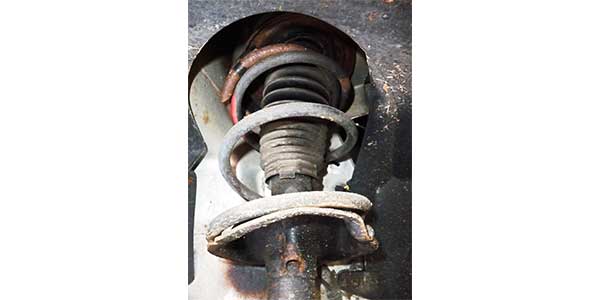
A lot of vehicles will go to the junkyard with the original shocks or strut units installed. These vehicles probably spent a lot of time on the roads bouncing and lurching around with the driver thinking that it was normal. Unfortunately, some cars and trucks got to the junkyard too soon because compromised handling and increased braking distances contributed to an accident.
The main reason why shocks and struts do not get replaced sooner is not the customer’s budget or because the OE units are better, it is because no one has explained the benefits of new shocks and struts to the vehicle owner and closed the sale.
Part of the reason selling shocks and struts is difficult is they are a wear item that rarely leaves the driver stranded by the side of the road, or with symptoms that get them into a shop to get a problem checked out.
Often, you are your own worst enemy when selling ride control.
Over time, salespeople can become apathetic to selling ride control products to customers.
The Three Phases of Apathy
The cycle of not selling ride control has three phases. It starts with the salesperson starts with the service writer or technician limiting ride control replacement recommendations to jobs or vehicles that have the greatest potential for a sale. In some cases, they might not mention the condition of the shocks and strut because it might scare the customer away from a required repair.
The second phase of this cycle starts with just listing the recommendation and estimate for shock or strut replacement on the estimate or final bill and maybe mentioning it casually to the customer during the sales process. These recommendations are “feelers” that do not close sales. The service writer might sound like a restaurant waiter unenthusiastically mumbling through the specials of the day.
The last phase is the most destructive to sales. This is where the service writer or technician stop mentioning or inspecting ride control components. They have a fear of being told “no” from the customer. Don’t take it personally!
Breaking the cycle of not recommending or selling ride control is difficult. The first thing you have to realize is that no customer wants to drive an unsafe vehicle when you recommend ride control you are selling better handling and shorter stopping distance. You are not selling comfort.
Inspection
The first step in selling ride control is the inspection process. A visual inspection of the shocks and struts can tell you a lot about the state of the ride control units. If possible, visual inspections should be performed before the test drive. This is a chance to make sure the vehicle is road worthy before you put your own life at risk. Also, always make sure that there is enough gas in the tank.
Communication
A complete inspection lays the groundwork for excellent customer communication and increases the possibility of a sale. The results of the inspection can help personalize the sales pitch to the individual customer.
The following is an example of how a note on an inspection form can provide so much more than a simple “recommend new shocks and struts.”
Salesperson: “On the test drive, the technician noticed excessive nose dive during braking and increased body roll while turning. Also, we noticed humming coming from the rear that was caused by uneven wear of the rear tires.”
Customer: “I guess it’s not exactly performing the same as it was when new and that humming noise was starting to annoy me.”
Salesperson: “New struts can help to return the vehicle to like it was when it was new. Also, they can prevent future uneven wearing of your tires.”
In this simple interchange of information, the information gained in the test drive helped to identify and define the value of new ride control components to the customer. Furthermore, the information given to the customer helped to create a tangible need that they can relate to on why the service should be performed. All of this was done without going into techno-speak.
Even if the customer does not buy today, this sales approach and pitch will likely stick with the consumer longer than the generic “recommend new shocks and struts.” This means that they might be back and your efforts will not be in vain.













